Mineral Water as a Sustainable Raw Material for Skincare Products and Protective Natural Antioxidant from Solar Irradiation: Stability of Vitamin C and In Vitro Antioxidant Assessments
Abstract
1. Introduction
2. Materials and Methods
2.1. Reagents and Chemicals
2.2. Sample Preparation and Analytical Procedures
3. Results and Discussion
3.1. Stability Study of Vitamin C
3.2. In Vitro Assessment of Antioxidative Activity
3.3. Pharmaceutical Technological Aspects
4. Conclusions
Author Contributions
Funding
Data Availability Statement
Conflicts of Interest
References
- Pham-Huy, L.A.; He, H.; Pham-Huy, C. Free radicals, antioxidants in disease and health. Int. J. Biomed. Sci. 2009, 4, 89–96. [Google Scholar] [CrossRef]
- Lobo, V.; Phatak, A.; Chandra, N. Free radicals, antioxidants and functional foods: Impact on human health. Pharmacogn. Rev. 2010, 4, 118–126. [Google Scholar] [CrossRef]
- Meng, J.-Y.; Zhang, C.-Y.; Zhu, F.; Wang, X.-P.; Lei, C.-L.J. Ultraviole light-induced oxidative stress: Effects on antioxidant response of Helicoverpa armigera adults. Insect Physiol. 2009, 55, 588–592. [Google Scholar] [CrossRef]
- Sindhi, V.; Gupta, V.; Sharma, K.; Bhatnagar, S.; Kumari, R.; Dhaka, N. Potential applications of antioxidants—A review. J. Pharm. Res. 2013, 7, 828–835. [Google Scholar] [CrossRef]
- Djekić, I.; Velebit, B.; Pavlić, B.; Putnik, P.; Šojić Merkulov, D.; Bebek Markovinović, A.; Bursać Kovačević, D. Food Quality 4.0: Sustainable Food Manufacturing for the Twenty-First Century. Food Eng. Rev. 2023, 15, 577–608. [Google Scholar] [CrossRef]
- Wilkinson, J.L.; Boxall, A.B.A.; Kolpin, D.W.; Leung, K.M.Y.; Lai, R.W.S.; Galbán-Malagón, C.; Adell, A.D.; Mondon, J.; Metian, M.; Marchant, R.A.; et al. Pharmaceutical pollution of the world’s rivers. Proc. Natl. Acad. Sci. USA 2022, 119, e2113947119. [Google Scholar] [CrossRef]
- Finčur, N.; Šojić Merkulov, D.; Putnik, P.; Despotović, V.; Banić, N.; Bognár, S.; Jovanović, D.; Panić, S.; Ivetić, T.; Abramović, B. Sunlight-Driven Degradation of Alprazolam and Amitriptyline by Application of Binary Zinc Oxide and Tin Oxide Powders. Separations 2023, 10, 316. [Google Scholar] [CrossRef]
- Despotović, V.; Finčur, N.; Bognar, S.; Šojić Merkulov, D.; Putnik, P.; Abramović, B.; Panić, S. Characterization and Photocatalytic Performance of Newly Synthesized ZnO Nanoparticles for Environmental Organic Pollutants Removal from Water System. Separations 2023, 10, 258. [Google Scholar] [CrossRef]
- Picot Groz, M.; Martinez Bueno, M.J.; Rosain, D.; Fenet, H.; Casellas, C.; Pereira, C.; Maria, V.; Bebianno, M.J.; Gomez, E. Detection of emerging contaminants (UV filters, UV stabilizers and musks) in marine mussels from Portuguese coast by QuEChERS extraction and GC-MS/MS. Sci. Total Environ. 2014, 493, 162–169. [Google Scholar] [CrossRef]
- Downs, C.A.; Kramarsky-Winter, E.; Segal, R.; Fauth, J.; Knutson, S.; Bronstein, O.; Ciner, F.R.; Jeger, R.; Lichtenfeld, Y.; Woodley, C.M.; et al. Toxicopathological effects of the sunscreen uv filter, oxybenzone (benzophenone-3), on coral planulae and cultured primary cells and its environmental contamination in Hawaii and the U.S. Virgin Islands. Arch. Environ. Contam. Toxicol. 2016, 70, 265–288. [Google Scholar] [CrossRef]
- Nitulescu, G.; Lupuliasa, D.; Adam-Dima, I.; Nitulescu, G.M. Ultraviolet filters for cosmetic applications. Cosmetics 2023, 10, 101. [Google Scholar] [CrossRef]
- Bubalo-Živković, M.; Lukić, T.; Đerčan, B.; Stojsavljević, R.; Bjelajac, D.; Ristanović, B. Thermal mineral waters of Vojvodina (Serbia) and the possibility of their use: A case study of the Municipality of Kikinda. Zb. Rad. Geogr. Fak. Univ. Beogr. 2018, 66, 53–70. [Google Scholar] [CrossRef]
- Yin, X.; Chen, K.; Cheng, H.; Chen, X.; Feng, S.; Song, Y.; Liang, L. Chemical Stability of Ascorbic Acid Integrated into Commercial Products: A Review on Bioactivity and Delivery Technology. Antioxidants 2022, 11, 153. [Google Scholar] [CrossRef]
- Neto, J.F.S.; Khan, S.D.S.; Filho, C.A.D.A.; Neto, A.G.D.C.; Torres, A.G.; Azevedo, E.P.P. Photostability of vitamin C in industrialized fruit juices and isomers determination by HPLC-DAD. J. Chromatogr. Open 2023, 4, 100103. [Google Scholar] [CrossRef]
- Noreen, A.; Anwar, Z.; Ejaz, M.A.; Usmani, M.; Khan, T.; Sheraz, M.A.; Ahmed, S.; Mirza, T.; Khurshid, A.; Ahmad, I. Riboflavin (vitamin B2) sensitized photooxidation of ascorbic acid (vitamin C): A kinetic study. Spectrochim. Acta A. 2024, 309, 123813. [Google Scholar] [CrossRef]
- Espin, J.C.; Soler-Rivas, C.; Wichers, H.J. Characterization of the total free radical scavenger capacity of vegetable oils and oil fractions using 2, 2-diphenyl-1-picrylhydrazyl radical. J. Agr. Food Chem. 2000, 48, 648–656. [Google Scholar] [CrossRef]
- Vidović, S.; Nastić, N.; Gavarić, A.; Cindrić, M.; Vladić, J. Development of green extraction process to produce antioxidant-rich extracts from purple coneflower. Sep. Sci. Technol. 2019, 54, 1174–1181. [Google Scholar] [CrossRef]
- Oyaizu, M. Studies on products of browning reaction antioxidative activities of products of browning reaction prepared from glucosamine. Jpn. J. Nutri. Diet. 1986, 44, 307–315. [Google Scholar] [CrossRef]
- Calza, P.; Pelizzetti, E. Photocatalytic transformation of organic compounds in the presence of inorganic ions. Pure Appl. Chem. 2001, 73, 1839–1848. [Google Scholar] [CrossRef]
- Wang, C.; Zhu, L.; Wei, M.; Chen, P.; Shan, G. Photolytic reaction mechanism and impacts of coexisting substances on photodegradation of bisphenol A by Bi2WO6 in water. Water Res. 2012, 46, 845–853. [Google Scholar] [CrossRef]
- Selvam, K.; Muruganandham, M.; Muthuvel, I.; Swaminathan, M. The influence of inorganic oxidants and metal ions on semiconductor sensitized photodegradation of 4-fluorophenol. Chem. Eng. J. 2007, 128, 51–57. [Google Scholar] [CrossRef]
- Wang, X.; Jia, J.; Wang, Y. Degradation of C.I. Reactive Red 2 through photocatalysis coupled with water jet cavitation. J. Hazard. Mat. 2011, 185, 315–321. [Google Scholar] [CrossRef]

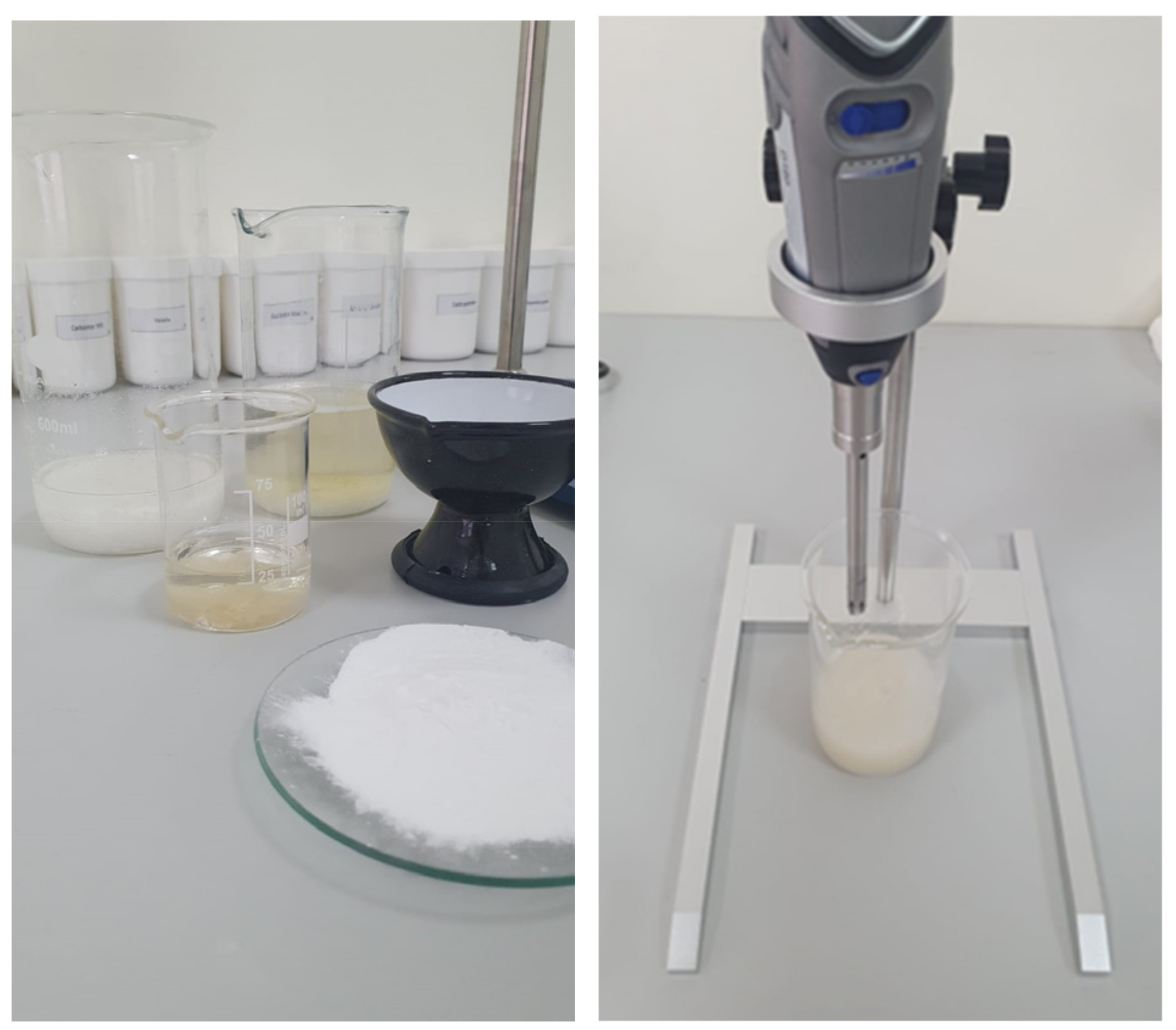
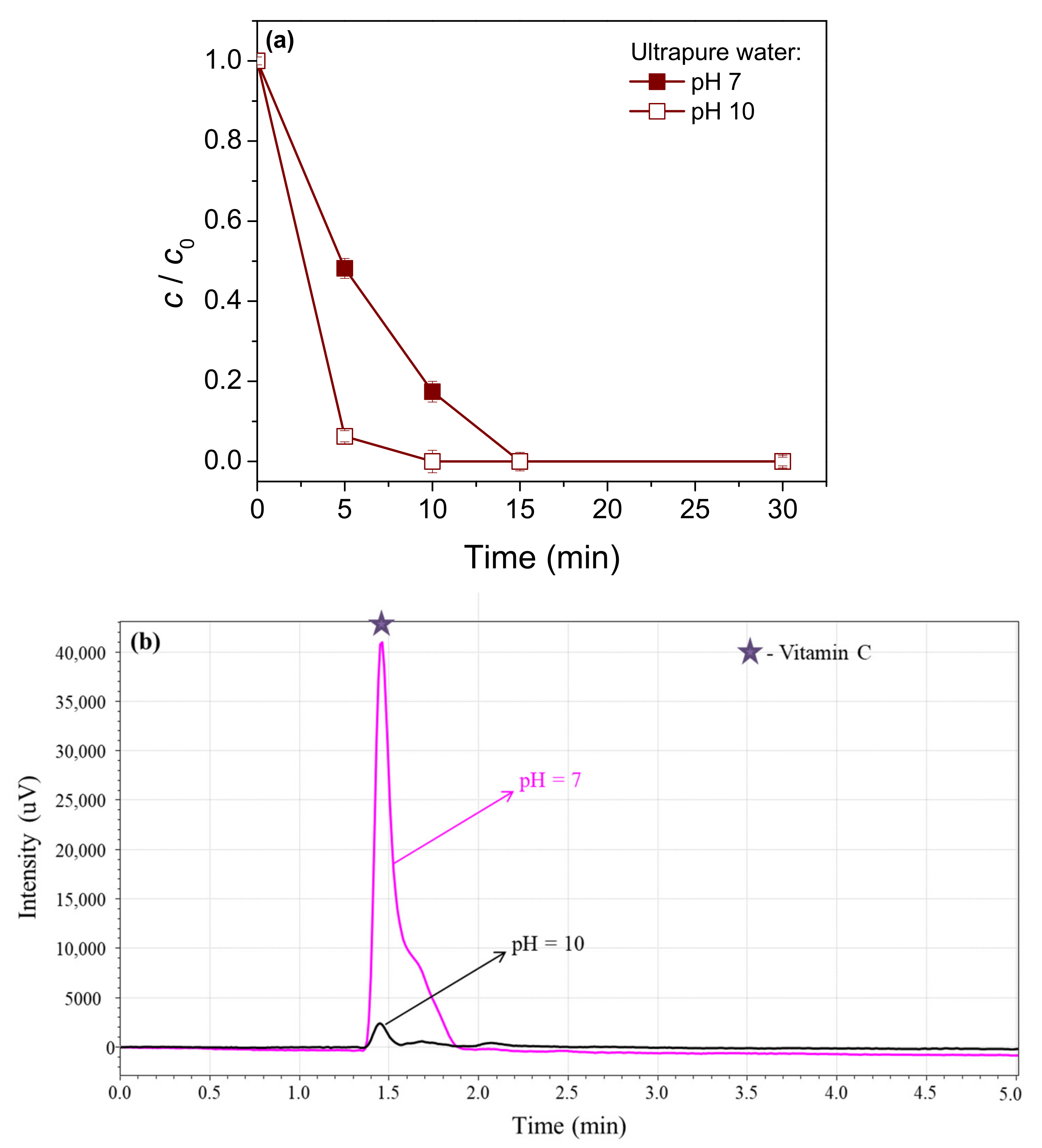
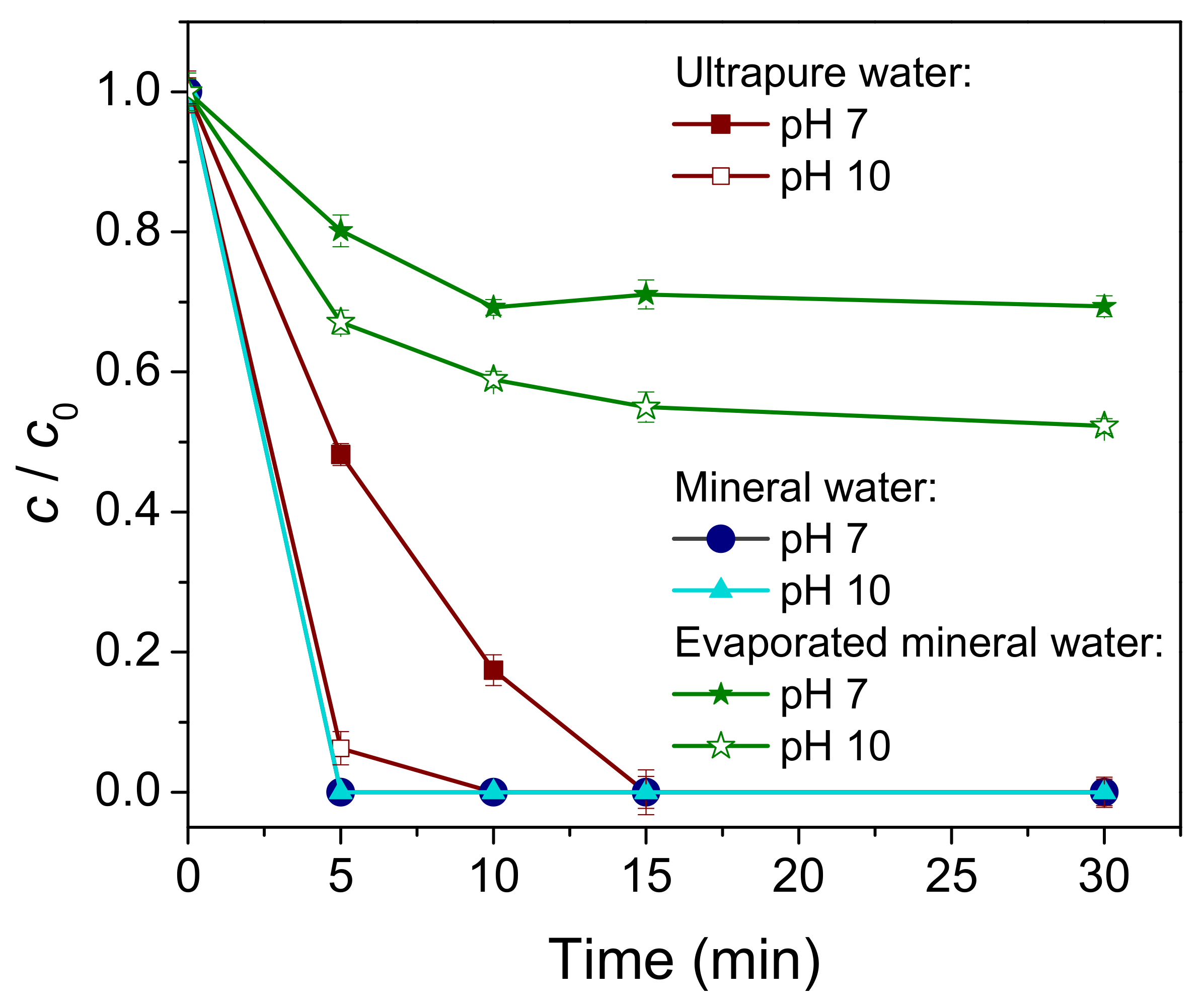
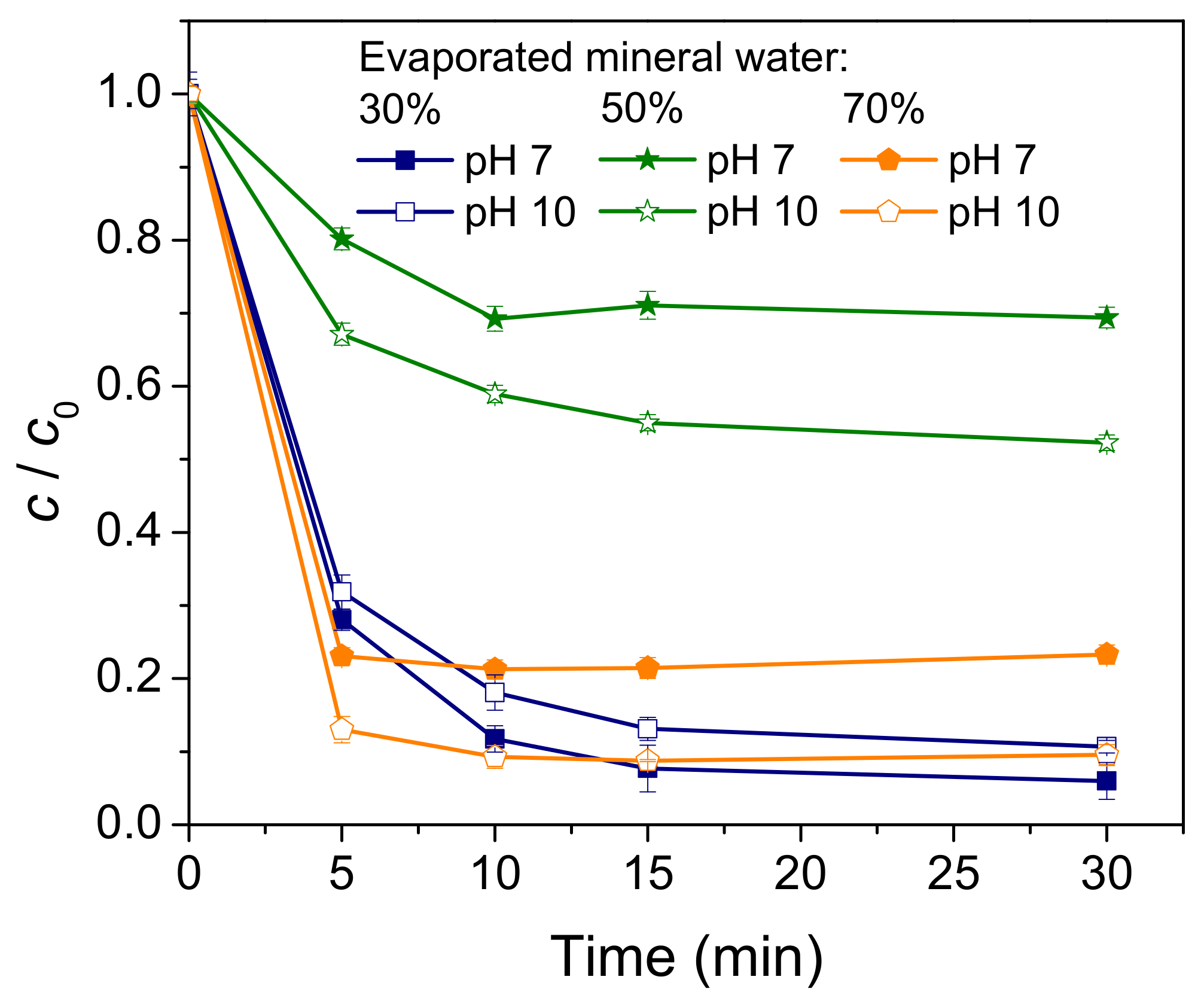
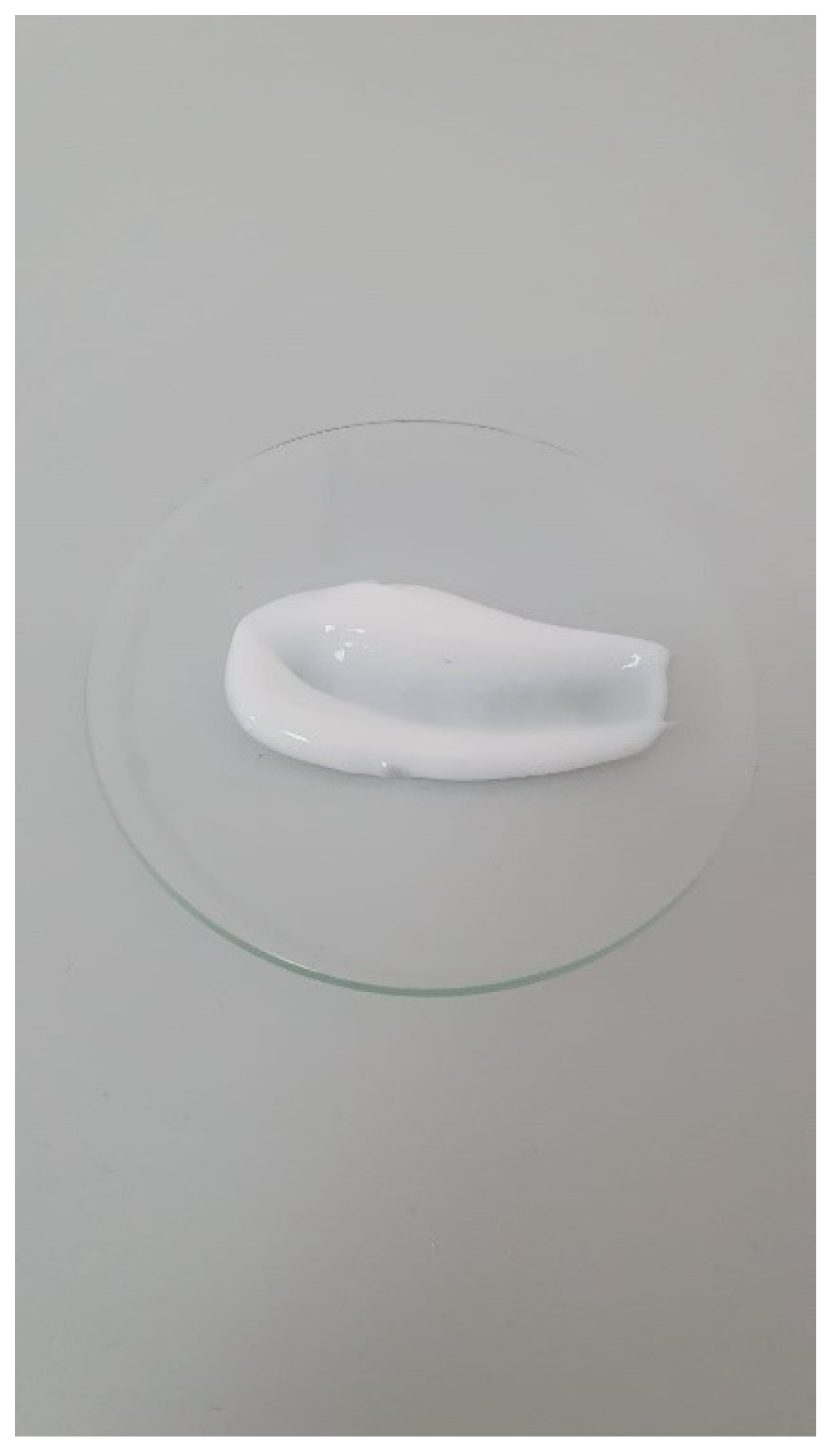

| Parameter | Value |
|---|---|
| pH | 7.9 |
| Sodium (g/L) | 1.298 |
| Potassium (g/L) | 0.0097 |
| Lithium (g/L) | 0.0001 |
| Ammonium (g/L) | 0.0002 |
| Calcium (g/L) | 0.0064 |
| Magnesium (g/L) | 0.0027 |
| Strontium (g/L) | 0.0004 |
| Manganese (g/L) | 0.00001 |
| Iron (g/L) | 0.00001 |
| Aluminum (g/L) | 0.00005 |
| Hydrogen carbonate (g/L) | 2.934 |
| Chloride (g/L) | 0.073 |
| Bromide (g/L) | 0.00013 |
| Iodide (g/L) | 0.0006 |
| Fluoride (g/L) | 0.0003 |
| Nitrate (g/L) | 0.0001 |
| Hydrogen phosphate (g/L) | 0.0002 |
| Sulphate (g/L) | 0.0009 |
| Sample | IC50 (mg/mL) | ||
|---|---|---|---|
| DPPH | ABTS | FRAP | |
| Mineral water | 2.26 ± 0.23 | 0.12 ± 0.05 | n.m. |
| Mineral water (50%) | 5.04 ± 0.12 | 0.14 ± 0.02 | n.m. |
| Mineral water (pH 5) | 2.52 ± 0.09 | n.m. | n.m. |
| Mineral water (50%, pH 5) | 19.3 ± 0.45 | 6.58 ± 0.28 | n.m. |
Disclaimer/Publisher’s Note: The statements, opinions and data contained in all publications are solely those of the individual author(s) and contributor(s) and not of MDPI and/or the editor(s). MDPI and/or the editor(s) disclaim responsibility for any injury to people or property resulting from any ideas, methods, instructions or products referred to in the content. |
© 2024 by the authors. Licensee MDPI, Basel, Switzerland. This article is an open access article distributed under the terms and conditions of the Creative Commons Attribution (CC BY) license (https://creativecommons.org/licenses/by/4.0/).
Share and Cite
Bognár, S.; Šojić Merkulov, D.; Finčur, N.; Putnik, P.; Katona, G.; Vojvodić, S.; Kalić, M.; Nastić, N.; Jovanović Lješković, N. Mineral Water as a Sustainable Raw Material for Skincare Products and Protective Natural Antioxidant from Solar Irradiation: Stability of Vitamin C and In Vitro Antioxidant Assessments. Processes 2024, 12, 1265. https://doi.org/10.3390/pr12061265
Bognár S, Šojić Merkulov D, Finčur N, Putnik P, Katona G, Vojvodić S, Kalić M, Nastić N, Jovanović Lješković N. Mineral Water as a Sustainable Raw Material for Skincare Products and Protective Natural Antioxidant from Solar Irradiation: Stability of Vitamin C and In Vitro Antioxidant Assessments. Processes. 2024; 12(6):1265. https://doi.org/10.3390/pr12061265
Chicago/Turabian StyleBognár, Szabolcs, Daniela Šojić Merkulov, Nina Finčur, Predrag Putnik, Gabor Katona, Slađana Vojvodić, Marina Kalić, Nataša Nastić, and Nataša Jovanović Lješković. 2024. "Mineral Water as a Sustainable Raw Material for Skincare Products and Protective Natural Antioxidant from Solar Irradiation: Stability of Vitamin C and In Vitro Antioxidant Assessments" Processes 12, no. 6: 1265. https://doi.org/10.3390/pr12061265
APA StyleBognár, S., Šojić Merkulov, D., Finčur, N., Putnik, P., Katona, G., Vojvodić, S., Kalić, M., Nastić, N., & Jovanović Lješković, N. (2024). Mineral Water as a Sustainable Raw Material for Skincare Products and Protective Natural Antioxidant from Solar Irradiation: Stability of Vitamin C and In Vitro Antioxidant Assessments. Processes, 12(6), 1265. https://doi.org/10.3390/pr12061265










